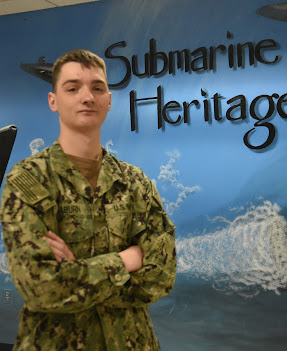GROTON, Conn. - Fireman Apprentice Ryan Saburn, a native of Duluth, Minnesota, is training to be part of the U.S. Navy’s 125-year tradition of service under the sea.
Saburn graduated from Duluth East High School in 2024.
The skills and values needed to succeed in the Navy are similar to those found in Duluth.
“Growing up, I learned the importance of putting your best foot forward,” Saburn said. “I learned to never do the bare minimum and to always give it your best effort.”
Saburn joined the Navy 10 months ago. Today, Saburn is a student at the Naval Submarine School, training to serve as a machinist’s mate (non-nuclear, submarine auxiliary) in the submarine force.
 |
| Photo by Fire Control Technician Seaman Recruit Duncan Woodward, Naval Submarine School |
Saburn graduated from Duluth East High School in 2024.
The skills and values needed to succeed in the Navy are similar to those found in Duluth.
“Growing up, I learned the importance of putting your best foot forward,” Saburn said. “I learned to never do the bare minimum and to always give it your best effort.”
Saburn joined the Navy 10 months ago. Today, Saburn is a student at the Naval Submarine School, training to serve as a machinist’s mate (non-nuclear, submarine auxiliary) in the submarine force.
“What inspired me to join the Navy was my family that had previously served,” Saburn said. “My brother, Samuel, is currently a specialist serving in the National Guard, my stepfather, Joel, previously served in the Marine Corps, and my uncle, Michael, served in the Army. I wanted to follow in their footsteps and serve my country just like them.”
Located aboard Naval Submarine Base New London, the Naval Submarine School is where officers and enlisted sailors receive the basic knowledge needed to join operational submarine commands in the fleet. U.S. Navy sailors are training at the schoolhouse alongside members of the Royal Australian Navy who are part of the AUKUS Pillar 1 Optimal Pathway, a partnership between Australia, the United Kingdom and the United States aimed at helping Australia acquire a conventionally armed, nuclear-powered submarine fleet.
Once in the fleet, the foundation established at submarine school allows sailors to build competence and proficiency in operating and maintaining submarines and all their systems. The school also provides refresher and advanced training to members of the submarine force and those supporting submarine commands to increase proficiency in specific skills.
Known as America’s “Apex Predators,” the U.S. Navy’s submarine force operates a large fleet of technologically advanced vessels. These submarines are capable of conducting rapid defensive and offensive operations around the world, in furtherance of U.S. national security.
After completing their training, Saburn will serve aboard or in support of one of the Navy’s three basic types of submarines: fast-attack submarines, ballistic-missile submarines and guided-missile submarines.
Fast-attack submarines are designed to hunt down and destroy enemy submarines and surface ships; strike targets ashore with cruise missiles; carry and deliver Navy SEALs; conduct intelligence, surveillance, and reconnaissance missions; and engage in mine warfare. The Virginia-class fast-attack submarine is the most advanced submarine in the world today. It combines stealth and payload capability to meet Combatant Commanders’ demands in this era of strategic competition.
The Navy’s ballistic-missile submarines, often referred to as “boomers,” serve as a strategic deterrent by providing an undetectable platform for submarine-launched ballistic missiles. They are designed specifically for stealth, extended patrols and the precise delivery of missiles. The Columbia-class ballistic-missile submarines will be the largest, most capable and most advanced submarines produced by the U.S., replacing the current Ohio-class ballistic-missile submarines to ensure continuous sea-based strategic deterrence into the 2080s.
Guided-missile submarines provide the Navy with unprecedented strike and special operation mission capabilities from a stealthy, clandestine platform. Each guided-missile submarine is capable of carrying 154 Tomahawk cruise missiles, plus a complement of heavyweight torpedoes to be fired through four torpedo tubes.
Strategic deterrence is the nation’s ultimate insurance program, according to Navy officials. As a member of the submarine force, Saburn is part of the rich 125-year history of the U.S. Navy’s most versatile weapons platform, capable of taking the fight to the enemy in the defense of America and its allies.
The U.S. Navy is celebrating its 250th birthday this year.
According to Navy officials, “America is a maritime nation and for 250 years, America’s Warfighting Navy has sailed the globe in defense of freedom.”
With 90% of global commerce traveling by sea and access to the internet relying on the security of undersea fiber optic cables, Navy officials continue to emphasize that the prosperity of the United States is directly linked to recruiting and retaining talented people from across the rich fabric of America.
Saburn has many opportunities to achieve accomplishments during military service.
“My proudest accomplishment is coming to submarine school,” Saburn said. “It’s a small-knit community, and you can connect with each other. I am on my way to completing a goal of mine of serving aboard submarines.”
Saburn serves a Navy that operates far forward, around the world and around the clock, promoting the nation’s prosperity and security.
“Serving in the Navy makes my family proud, and I am enjoying what I am learning to do that comes with my rate,” Saburn said. “I would like to make the rank of chief petty officer, and I want to master my rate the best way possible and be the best I can be."
Saburn is grateful to others for helping make a Navy career possible.
“I would like to thank my brother, Sam, for all of his encouragement and support,” Saburn added.